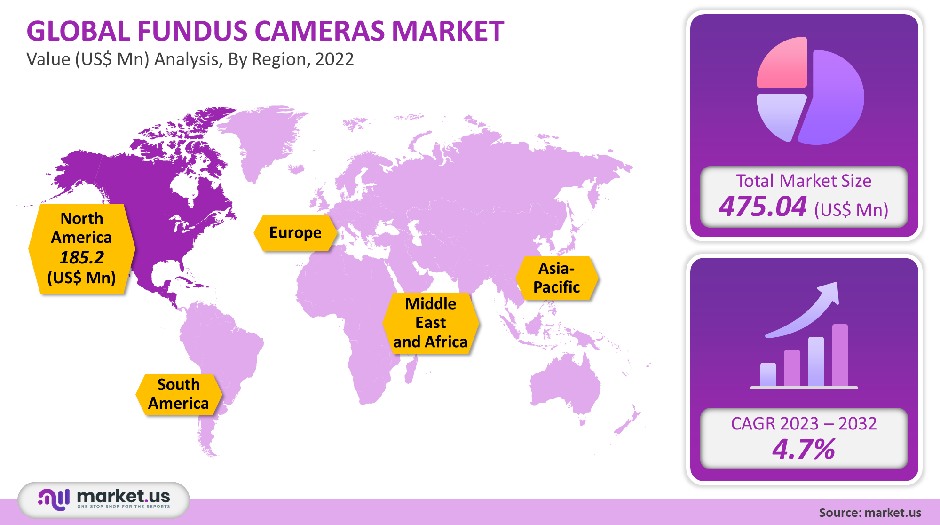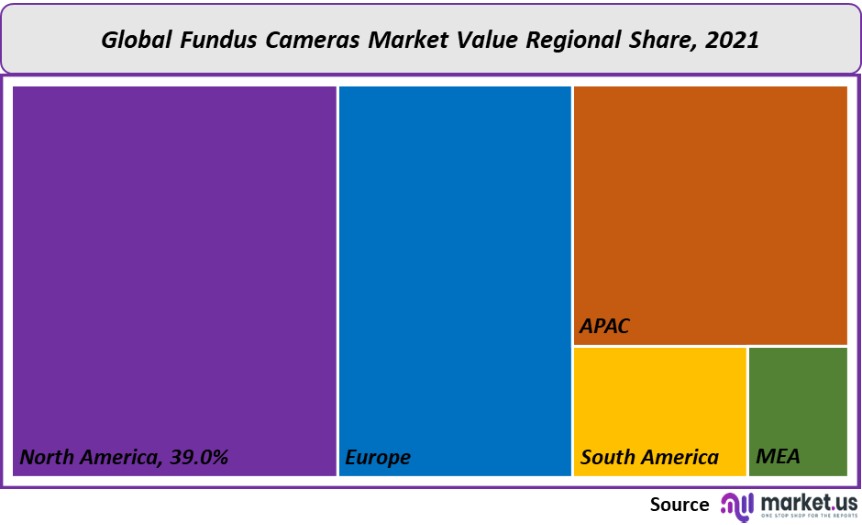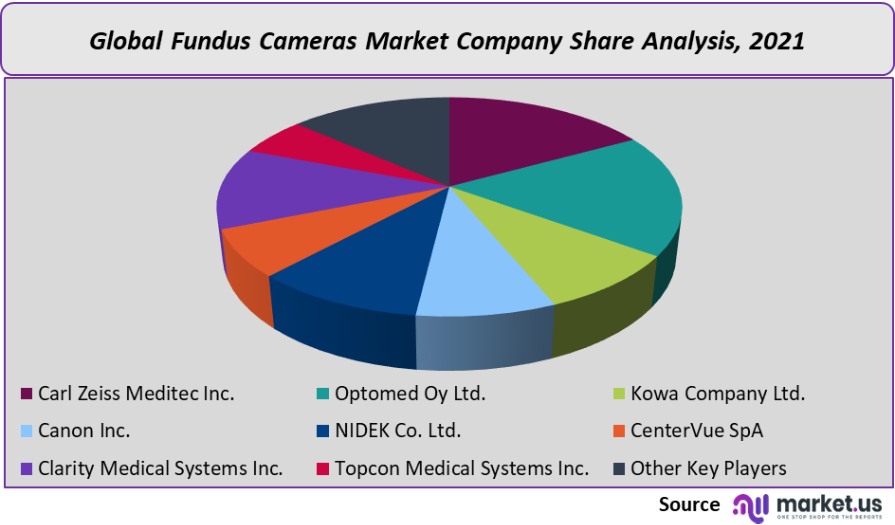Global Fundus Cameras Market By Product (Mydriatic Fundus Cameras, Non-Mydriatic Fundus Cameras, and Others), By End-Use (Hospitals, Ophthalmic & Optometrist Offices, and Others), By Region and Companies - Industry Segment Outlook, Market Assessment, Competition Scenario, Trends and Forecast 2022-2032
- Published date: May 2023
- Report ID: 21929
- Number of Pages: 283
- Format:
- keyboard_arrow_up
Quick Navigation
Fundus Cameras Market Overview:
The global market for Fundus Cameras was valued at USD 475.04 million in 2021. This market is expected to grow at a 4.7% CAGR between 2023 and 2032.
Retinal disorders are on the rise due to the increasing prevalence of chronic diseases such as hypertension, diabetes, and geriatrics. Age-related Macular Degeneration, Diabetic Retinopathy (DR), and Retinopathy of Prematurity are key retinal disorders. The market is expected to grow due to increased awareness about eye conditions and the commercialization of many technologically advanced products.
Global Fundus Cameras Market Analysis
Product Analysis
Market leader, Non-Mydriatic cameras, accounted for 50% revenue share in 2021. This improves the ability of a practitioner to see detailed retinal anatomy, which, in turn, helps with diagnosis and management. Fundus photography can also be used by non-mydriatic cameras, which reduces the need for bright lights and dilating droplets.
Fundus photography is thus more patient-friendly. This helps patients suffering from glaucoma, for whom dilation may not be necessary. Market growth is expected to be driven by advances in non-mydriatic digital cameras such as fluorescein image, live-action systems, portability, and fluorescein imaging. The segment of mydriatic fundus cameras held an average revenue share in 2021.
This is due to the need to dilate the pupil with bright light or a dilating drop in order to get a clear view of the retina. For patients with photosensitivity or glaucoma, this is uncomfortable. The fundus cameras have made it easier to capture reliable, clear, and quick images of the retina.

End Use Analysis
Ophthalmic and optometrist practices dominated the market in 2021. The fastest growth rate is anticipated to be 5.5% over the forecast period. This is due to the increasing number of optometrists and preference for primary eye care. Also, optometrists will offer lower-cost services than ophthalmologists.
Optometric offices can also dominate the market because of the stagnant supply of ophthalmologists. The lack of optometrists is a major reason for the increased demand for optometrists from emerging regions, such as the Asia Pacific, Latin America, and Africa.
Hospitals offer a variety of services, including secondary care, tertiary and advanced care. Hospitals are most preferred for complicated procedures, such as pediatric eye care. There may be a slowdown in the market’s growth due to the preference for specialty eye clinics such as optometrist offices and ophthalmologist clinics.
Complex cases will see a rise in demand for specialist ophthalmologists. The market may not grow due to the high cost of eye examinations, insufficient ophthalmologists available, and the low preference of patients for seeing ophthalmologists when it comes to primary care.
Key Market Segments
By Product
- Mydriatic Fundus Cameras
- Non-Mydriatic Fundus Cameras
- ROP Fundus Cameras
- Hybrid Fundus Cameras
By End-Use
- Hospitals
- Ophthalmic & Optometrist Offices
- Ophthalmology Clinics
Market Dynamics
One group of conditions called diabetic eye diseases is DR, diabetic Macular Edema, glaucoma, and cataract. The market is expected to be driven by advancements in this field during the forecast period. COVID-19 had a negative impact on the market because the data collected during the pandemic were not reliable and sufficient to identify the eye problem. Data shortages made it difficult for the treatment and management of diseases to be traced. Because they are portable, fundus cameras can still be useful in this pandemic. They will capture retinal changes in COVID victims in different locations and settings.
Market growth is expected to be driven by advances in the Digital Camera, the film-based Fundus Camera, the red-free Fundus Camera, and other fundus imaging technologies. Also, the adoption of these new technologies in emerging nations will drive this market. Market growth is also expected to be driven by supportive government regulations.
According to Japanese and U.S. laws, fundus imaging cameras must be replaced at least once every four years. This law preserves the quality and enhances diagnosis and treatment. This law is expected to keep the market thriving and maintain demand for devices in all countries.
However, market growth is expected to be limited by pricing pressures and competition from other technologies. Optical Coherence Tomography, an advanced technology used for retinal reimaging, is a new technology. The technology can provide detailed images of the optic nerve and retina, which can be viewed in both 2D and 3D formats. Swept-source OCT uses the latest Fourier domain OCT technology. The advantages of swept-source OCT include better sensitivity, faster speed, and greater accuracy than OCT.
Regional Analysis
North America was the dominant market for fundus cameras in 2021, holding a 39% revenue share. This region has seen significant growth due to technological advances and the growing geriatric population. Market share is likely to rise due to the launch and approval of fundus cameras across the U.S. and Canada, as well as the widespread adoption of new technologies.
The market is likely to grow during the forecast period due to the widespread use of fundus cameras for screening and early detection not only for diseases related to eye disease but also lifestyle-related diseases.
Europe’s market is expected to grow at a 5.1% CAGR over the forecast period. This can be attributed to the regional presence of market leaders, technological advancements in fundus camera technology, such as the development of hybrid cameras and easy-to-use, portability, and design of hybrid cameras, and the adoption of more advanced products.
Due to the growing popularity of medical tourism, Asia Pacific will see a 6.0% CAGR over the forecast period. Asia Pacific’s market is driven primarily by China, India, Australia, and Japan. Japan held a significant revenue share of the market in 2021. This can be attributed both to the strong presence of market players within the country and to the large geriatric population. China will likely be the fastest growing market in the Asia Pacific during the forecast period.

Key Regions and Countries covered іn thе rероrt:
- North America
- US
- Canada
- Mexico
- Europe
- Germany
- UK
- France
- Italy
- Russia
- Spain
- Rest of Europe
- APAC
- China
- Japan
- South Korea
- India
- Rest of Asia-Pacific
- South America
- Brazil
- Argentina
- Rest of South America
- MEA
- GCC
- South Africa
- Israel
- Rest of MEA
The company’s main strategies include expanding its global sales network and establishing new production systems. They also aim to improve their R&D capabilities. Topcon Corporation bought 51.0% of Mehra Eyetech Private Limited. Topcon India distributes the ophthalmic device. This acquisition is expected to strengthen Topcon’s position in the Indian market.
Optomed Oy and Essilor GmbH signed a distribution agreement in Germany for the ophthalmic products. Market players should take such strategic steps to boost the market in the forecast period.

Мarkеt Кеу Рlауеrѕ:
- Carl Zeiss Meditec Inc.
- Optomed Oy Ltd.
- Kowa Company Ltd.
- Canon Inc.
- NIDEK Co., Ltd.
- CenterVue SpA
- Clarity Medical Systems Inc.
- Topcon Medical Systems Inc.
- Other Key Players
For the Fundus Cameras Market research study, the following years have been considered to estimate the market size:
Attribute Report Details Historical Years
2016-2020
Base Year
2021
Estimated Year
2022
Short Term Projection Year
2028
Projected Year
2023
Long Term Projection Year
2032
Report Coverage
Competitive Landscape, Revenue analysis, Company Share Analysis, Manufacturers Analysis, Volume by Manufacturers, Key Segments, Key company analysis, Market Trends, Distribution Channel, Market Dynamics, COVID-19 Impact Analysis, strategy for existing players to grab maximum market share, and more.
Regional Scope
North America, Europe, Asia-Pacific, South America, Middle East & Africa
Country Scope
United States, Canada and Mexico, Germany, France, UK, Russia and Italy, China, Japan, Korea, India and Southeast Asia, Brazil, Argentina, Colombia etc.Saudi Arabia, UAE, Egypt, Nigeria and South Africa
Frequently Asked Questions (FAQ)
Q: What is the size of the Fundus Cameras market in 2021?A: The Fundus Cameras market size is US$ 475.04 million in 2021.
Q: What is the projected CAGR at which the Fundus Cameras market is expected to grow at?A: The Fundus Cameras market is expected to grow at a CAGR of 4.7% (2023-2032).
Q: List the segments encompassed in this report on the Fundus Cameras market?A: Market.US has segmented the Fundus Cameras market by geographic (North America, Europe, APAC, South America, and Middle East and Africa). By Product, the market has been segmented into Mydriatic Fundus Cameras, Non-Mydriatic Fundus Cameras, ROP Fundus Cameras, and Hybrid Fundus Cameras. By End-Use, the market has been further divided into Hospitals, Ophthalmic & Optometrist Offices, and Ophthalmology Clinics.
Q: List the key industry players of the Fundus Cameras market?A: Carl Zeiss Meditec Inc., Optomed Oy Ltd., Kowa Company Ltd., Canon Inc., NIDEK Co. Ltd., CenterVue SpA, Clarity Medical Systems Inc., Topcon Medical Systems Inc., Other Key Players are engaged in the Fundus Cameras market.
Q: Which region is more appealing for vendors employed in the Fundus Cameras market?A: North America is expected to account for the highest revenue share of 39%. Therefore, the Fundus Cameras industry in North America is expected to garner significant business opportunities over the forecast period.
Q: Name the key areas of business for Fundus Cameras?A: The US, Canada, UK, Japan, Mexico, India, China & Germany are key areas of operation for the Fundus Cameras Market.
Q: Which segment accounts for the greatest market share in the Fundus Cameras industry?A: With respect to the Fundus Cameras industry, vendors can expect to leverage greater prospective business opportunities through the Non-Mydriatic Fundus Cameras segment, as this area of interest accounts for the largest market share.

- Carl Zeiss Meditec Inc.
- Optomed Oy Ltd.
- Kowa Company Ltd.
- Canon Inc.
- NIDEK Co., Ltd.
- CenterVue SpA
- Clarity Medical Systems Inc.
- Topcon Medical Systems Inc.
- Other Key Players
- settingsSettings
Our Clients
| Single User $4,599 $3,499 USD / per unit save 24% | Multi User $5,999 $4,299 USD / per unit save 28% | Corporate User $7,299 $4,999 USD / per unit save 32% | |
|---|---|---|---|
| e-Access | |||
| Report Library Access | |||
| Data Set (Excel) | |||
| Company Profile Library Access | |||
| Interactive Dashboard | |||
| Free Custumization | No | up to 10 hrs work | up to 30 hrs work |
| Accessibility | 1 User | 2-5 User | Unlimited |
| Analyst Support | up to 20 hrs | up to 40 hrs | up to 50 hrs |
| Benefit | Up to 20% off on next purchase | Up to 25% off on next purchase | Up to 30% off on next purchase |
| Buy Now ($ 3,499) | Buy Now ($ 4,299) | Buy Now ($ 4,999) |











